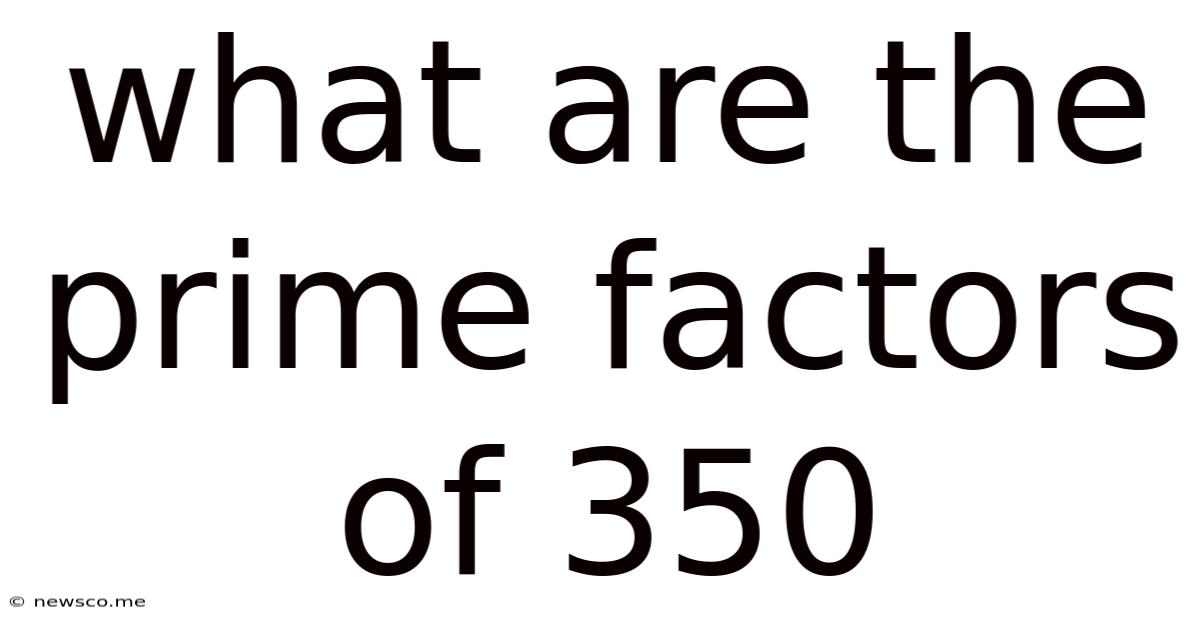What Are The Prime Factors Of 350
News Co
Apr 10, 2025 · 5 min read

Table of Contents
What Are the Prime Factors of 350? A Deep Dive into Prime Factorization
Finding the prime factors of a number might seem like a simple mathematical exercise, but understanding the process reveals fundamental concepts in number theory and has practical applications in various fields. This comprehensive guide explores how to find the prime factors of 350, explaining the method in detail and expanding on the broader significance of prime factorization.
Understanding Prime Numbers and Prime Factorization
Before we delve into the specifics of 350, let's solidify our understanding of key terms:
Prime Numbers: A prime number is a natural number greater than 1 that has no positive divisors other than 1 and itself. In simpler terms, it's only divisible by 1 and itself. Examples include 2, 3, 5, 7, 11, and so on. 2 is the only even prime number.
Composite Numbers: A composite number is a positive integer that has at least one divisor other than 1 and itself. Essentially, it's a number that can be factored into smaller positive integers. Examples include 4 (2 x 2), 6 (2 x 3), 9 (3 x 3), and so on.
Prime Factorization: Prime factorization (or integer factorization) is the process of finding the prime numbers that, when multiplied together, equal the original number. Every composite number can be uniquely expressed as a product of prime numbers. This is known as the Fundamental Theorem of Arithmetic.
Finding the Prime Factors of 350: A Step-by-Step Approach
There are several methods to find the prime factors of a number. Let's use the most common and straightforward approach for 350:
1. Start with the Smallest Prime Number: The smallest prime number is 2. We check if 350 is divisible by 2. Since 350 is an even number, it is divisible by 2.
350 ÷ 2 = 175
2. Continue with the Next Prime Number: Now we have 175. It's not divisible by 2 (it's odd). Let's move to the next prime number, 3. 175 is not divisible by 3 (the sum of its digits, 1 + 7 + 5 = 13, is not divisible by 3).
3. Check Divisibility by 5: The next prime number is 5. 175 ends in 5, so it's divisible by 5.
175 ÷ 5 = 35
4. Another Factor of 5: We now have 35. This is also divisible by 5.
35 ÷ 5 = 7
5. The Final Prime Factor: We're left with 7, which is a prime number. We can't factor it further.
Therefore, the prime factorization of 350 is 2 x 5 x 5 x 7, or 2 x 5² x 7.
Visualizing Prime Factorization: The Factor Tree
A factor tree is a helpful visual aid for prime factorization. Here's how it looks for 350:
350
/ \
2 175
/ \
5 35
/ \
5 7
Each branch ends in a prime number. The prime factors are read from the ends of the branches: 2, 5, 5, and 7.
Applications of Prime Factorization
While finding the prime factors of 350 might seem purely academic, the process has significant applications in various fields:
1. Cryptography:
Prime numbers are fundamental to modern cryptography, particularly in public-key cryptosystems like RSA. The security of these systems relies on the difficulty of factoring very large numbers into their prime factors. The larger the numbers, the more computationally intensive the factorization becomes.
2. Number Theory:
Prime factorization is a cornerstone of number theory, a branch of mathematics concerned with the properties of integers. Many important theorems and concepts in number theory rely on the unique prime factorization of integers.
3. Computer Science:
Algorithms for prime factorization are used in various computer science applications, including data compression, hashing, and random number generation. Efficient algorithms for prime factorization are an area of ongoing research.
4. Mathematics Education:
Understanding prime factorization helps build a strong foundation in number sense and mathematical reasoning. It's a crucial concept taught in elementary and middle school mathematics.
Beyond 350: Exploring Different Factorization Techniques
While the method used above is straightforward for smaller numbers like 350, larger numbers might require more sophisticated techniques. Let's briefly explore some alternative methods:
1. Trial Division:
This is the most basic method, similar to the one used for 350. It involves systematically testing divisibility by prime numbers, starting with the smallest. However, this becomes computationally expensive for very large numbers.
2. Pollard's Rho Algorithm:
This is a probabilistic algorithm used for factoring composite numbers. It's significantly faster than trial division for larger numbers, but it doesn't guarantee finding all factors.
3. General Number Field Sieve (GNFS):
This is currently the fastest known algorithm for factoring very large numbers. It's used in breaking RSA encryption with extremely large keys. It's highly complex and requires significant computational resources.
Conclusion: The Importance of Prime Factors
Understanding prime factorization, even for a seemingly simple number like 350, provides valuable insight into the fundamental building blocks of numbers. The seemingly straightforward process of finding the prime factors of 350 unlocks a gateway to appreciating the deeper complexities and applications of number theory and its influence on various aspects of mathematics and computer science. The unique factorization of integers into prime numbers is not just a mathematical curiosity; it's a cornerstone of many significant advancements in technology and theoretical mathematics. From the security of online transactions to the development of sophisticated algorithms, the seemingly simple concept of prime factorization plays a surprisingly large role in the modern world.
Latest Posts
Related Post
Thank you for visiting our website which covers about What Are The Prime Factors Of 350 . We hope the information provided has been useful to you. Feel free to contact us if you have any questions or need further assistance. See you next time and don't miss to bookmark.